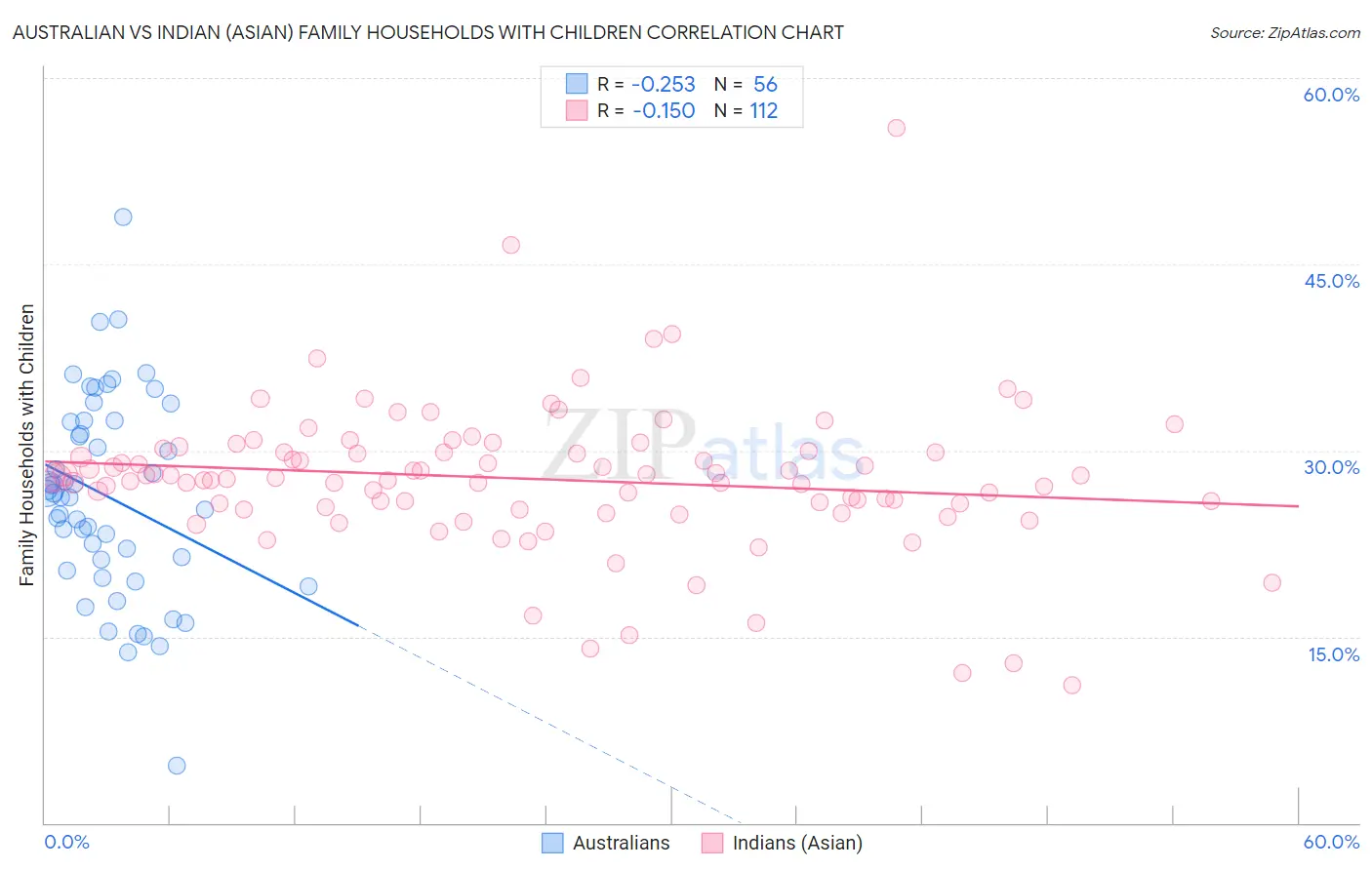Australian vs Indian (Asian) Family Households with Children
COMPARE
Australian
Indian (Asian)
Family Households with Children
Family Households with Children Comparison
Australians
Indians (Asian)
26.9%
FAMILY HOUSEHOLDS WITH CHILDREN
2.8/ 100
METRIC RATING
245th/ 347
METRIC RANK
27.6%
FAMILY HOUSEHOLDS WITH CHILDREN
71.6/ 100
METRIC RATING
157th/ 347
METRIC RANK
Australian vs Indian (Asian) Family Households with Children Correlation Chart
The statistical analysis conducted on geographies consisting of 223,944,645 people shows a weak negative correlation between the proportion of Australians and percentage of family households with children in the United States with a correlation coefficient (R) of -0.253 and weighted average of 26.9%. Similarly, the statistical analysis conducted on geographies consisting of 494,524,246 people shows a poor negative correlation between the proportion of Indians (Asian) and percentage of family households with children in the United States with a correlation coefficient (R) of -0.150 and weighted average of 27.6%, a difference of 2.5%.

Family Households with Children Correlation Summary
| Measurement | Australian | Indian (Asian) |
| Minimum | 4.6% | 11.1% |
| Maximum | 48.8% | 55.9% |
| Range | 44.2% | 44.9% |
| Mean | 26.3% | 27.7% |
| Median | 26.4% | 27.8% |
| Interquartile 25% (IQ1) | 20.8% | 25.6% |
| Interquartile 75% (IQ3) | 32.4% | 29.9% |
| Interquartile Range (IQR) | 11.6% | 4.3% |
| Standard Deviation (Sample) | 8.1% | 5.9% |
| Standard Deviation (Population) | 8.0% | 5.9% |
Similar Demographics by Family Households with Children
Demographics Similar to Australians by Family Households with Children
In terms of family households with children, the demographic groups most similar to Australians are Ukrainian (26.9%, a difference of 0.020%), Immigrants from Saudi Arabia (26.9%, a difference of 0.030%), Jamaican (26.9%, a difference of 0.070%), Immigrants from Bulgaria (26.9%, a difference of 0.090%), and Navajo (26.9%, a difference of 0.090%).
| Demographics | Rating | Rank | Family Households with Children |
| Moroccans | 3.4 /100 | #238 | Tragic 26.9% |
| Immigrants | Southern Europe | 3.4 /100 | #239 | Tragic 26.9% |
| Immigrants | Bulgaria | 3.3 /100 | #240 | Tragic 26.9% |
| Navajo | 3.2 /100 | #241 | Tragic 26.9% |
| Immigrants | England | 3.2 /100 | #242 | Tragic 26.9% |
| Immigrants | Saudi Arabia | 2.9 /100 | #243 | Tragic 26.9% |
| Ukrainians | 2.9 /100 | #244 | Tragic 26.9% |
| Australians | 2.8 /100 | #245 | Tragic 26.9% |
| Jamaicans | 2.5 /100 | #246 | Tragic 26.9% |
| Potawatomi | 2.2 /100 | #247 | Tragic 26.9% |
| Immigrants | Kazakhstan | 2.2 /100 | #248 | Tragic 26.9% |
| Immigrants | Eastern Europe | 2.1 /100 | #249 | Tragic 26.9% |
| Belgians | 2.1 /100 | #250 | Tragic 26.9% |
| Immigrants | Bosnia and Herzegovina | 1.9 /100 | #251 | Tragic 26.8% |
| Irish | 1.8 /100 | #252 | Tragic 26.8% |
Demographics Similar to Indians (Asian) by Family Households with Children
In terms of family households with children, the demographic groups most similar to Indians (Asian) are Romanian (27.6%, a difference of 0.020%), Mongolian (27.6%, a difference of 0.020%), Hungarian (27.6%, a difference of 0.080%), Comanche (27.6%, a difference of 0.090%), and Icelander (27.6%, a difference of 0.10%).
| Demographics | Rating | Rank | Family Households with Children |
| Argentineans | 78.5 /100 | #150 | Good 27.6% |
| Portuguese | 77.8 /100 | #151 | Good 27.6% |
| Ethiopians | 77.0 /100 | #152 | Good 27.6% |
| Immigrants | Cabo Verde | 75.6 /100 | #153 | Good 27.6% |
| Icelanders | 75.3 /100 | #154 | Good 27.6% |
| Comanche | 74.8 /100 | #155 | Good 27.6% |
| Hungarians | 74.6 /100 | #156 | Good 27.6% |
| Indians (Asian) | 71.6 /100 | #157 | Good 27.6% |
| Romanians | 70.8 /100 | #158 | Good 27.6% |
| Mongolians | 70.7 /100 | #159 | Good 27.6% |
| Sub-Saharan Africans | 67.5 /100 | #160 | Good 27.6% |
| Alaskan Athabascans | 67.1 /100 | #161 | Good 27.6% |
| Immigrants | Bangladesh | 67.0 /100 | #162 | Good 27.6% |
| Czechs | 65.3 /100 | #163 | Good 27.5% |
| Immigrants | Hong Kong | 64.9 /100 | #164 | Good 27.5% |